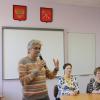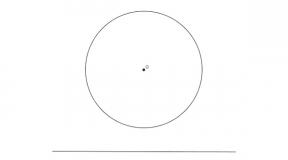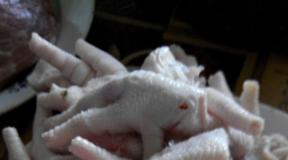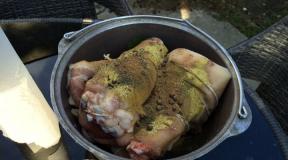Stages of speech development in children. Cheat sheet: Specifics of speech development disorders in young children The main stages of child speech development
In infancy, the physiological and psychological prerequisites for speaking mature. In the second year, the baby learns human speech, but still without declensions and conjugations, prepositions and conjunctions. Grammatically developed oral speech develops in the third year, but even a three-year-old child makes many mistakes, both morphological and in word formation.

It can be accepted that the entire primary preschool age is the age of development of grammatically correct oral speech. Senior preschool age can be called the age of socially standardized speech; at this age, the child learns to speak clearly for strangers, politely in the sense that is customary in his social environment, etc. School age is the age of mastering written speech. This does not mean, of course, that his oral speech has reached perfection grammatically and socially: it still has to be further developed in many respects both in terms of literary correctness and in terms of cultural speech. But mastering written language still figures in the foreground. What is specific to a schoolchild is what he writes and reads.
Of the two processes - reading and writing - learning to write depends to a much lesser extent on mental development: after manual labor and drawing, penmanship and calligraphy are the most accessible subject for mentally retarded children. The student encounters obstacles to mastering writing not from the brain, but from the hand.
The earliest obstacle is the predominance of large muscles over small muscles in a small schoolchild. He first writes the consequence of this in very large letters. Giving him a notebook with too narrow rulers means overly tiring his still poorly developed small muscles: hence fatigue, dislike of writing, frequent lifting of his hand when writing, too slow handwriting. In school practice, a first grader usually starts with letters 1 cm high, and in grades II and III he writes with half-centimeter letters. Modeling and drawing activities promote the development of small muscles of the hand.
Flexor muscles usually develop before extensor muscles. When we write, as always, from left to right, the hand tends to extend. Some children start by writing from right to left. In such cases, it is useful to practice the child in moving his hand (without a pen, and then with a pen) across the notebook from left to right.
Some children write in mirror writing at the very beginning. This is especially true for left-handed people who have just started writing with their right hand. This is how we write if we are forced to write in unusual conditions, for example, writing on a piece of paper on our forehead with our eyes closed. This indicates that for this child, writing is still a very unusual process. In such cases, it is necessary: 1) let the child only copy from the model, and not write on his own; 2) when copying, copy slowly, monitoring each letter written with your vision.
The child's fingertips are not flexible. His thumb is especially poorly developed. Therefore, the child holds the pen in a peculiar way: the thumb is poorly positioned, the index finger presses the entire pen, and not just the tip, the middle finger is positioned incorrectly. The result is angular handwriting. Modeling parts, pencil drawing, weaving, sewing, etc. are good for developing fingertips. In addition, beginner children should not be allowed to write letters with complex curves and curls. Due to the characteristics of children's muscles, when a child writes, the back of the hand is turned to the right, and the hand lies with the machine part on the notebook, and the pen is held straight or beveled to the left. This results in incorrect inclination of the letters, soiling of the notebook by hand, and faster hand fatigue. A way out of the situation: either create a special children's feather, or exercise the muscles that turn the hand to the left. Of the existing feathers, the dull ones are suitable for children. Likewise, a handle suitable for a child's hand is necessary. While there is no scientifically developed children's pen, we have to be guided by what kind of pen the child likes to write with.
Usually in a notebook, the first lines are better than the middle ones, and the middle ones are better than the last ones. If the notebook is wide, then the line begins to be beveled towards the end of the ruler. Such a notebook must have margins.
Children love planning their notebooks and decorating them. Children usually feel burdened by a dirty, bad notebook and strive to get rid of it as quickly as possible. It is extremely important to teach children to handle their notebooks with care from the very beginning. Teacher monitoring of children's notebooks and public viewing of them by children, as often as possible, are very helpful. In children, the pressure is on average stronger than in adults.
In general, we can summarize the handwriting shortcomings of a student starting to write as follows:
1) the size of the letters is very large;
2) the slope is rather straight, uneven;
3) pressure - strong, uneven;
4) lines are not added;
5) the distances between letters and words are uneven;
6) the shape of the letters is not always correct;
7) a page with marks, sometimes with unfinished lines.
When analyzing children's handwriting, it is very important to indicate exactly what its shortcomings are. Girls, on average, write slightly better than boys.
Writing speed increases in all years of primary school, but especially in the first year. In general, the writing speed in fourth grade can be considered normal if it is equal to 60 letters per minute when “writing from memory.” This speed can be considered sufficient in everyday life. Boys, according to some data, write somewhat faster than girls. Of the letters, the easiest for children are those that do not extend beyond the line (and of them are oval), and the most difficult are those that extend below the line.
So to the end 1 month In life, a healthy baby already reacts to communication with him: he stops crying and focuses on the adult.
2 month is characterized by a smile when communicating, and at 6 weeks it will most likely be a kind of “oral attention,” while at 8 weeks it will be a natural smile.
3 months. There is a complex of revival when communicating with an adult, “hooking.” Such sounds arise as a reaction to a smile and conversation between an adult and a child, vowel sounds predominate, as well as consonants g, k, n .
4 months. The first laughter appears - a squeal in response to emotional communication with an adult, and by 16 weeks the laughter becomes prolonged.
5 months. The child reacts to the direction of the sound, “sings”, changing the intonation of his voice.
6 months. By this time, a healthy child appears the first syllable ba or ma . An initial understanding of addressed speech arises: the child listens to the adult’s voice, reacts correctly to intonation, and recognizes familiar voices.
7 months. The baby is already ready for play activities with an adult, uses various vocal reactions to attract the attention of others.
8 months. There is a reaction to an unfamiliar face. At this time, one of the most important indicators of normal speech development is babbling, i.e. repetition of the same syllables: ba-ba, yes, yes, pa-pa and so on. Sounds used in speech: p, b, m, g, k, e, a .
9 months. The child actively communicates using gestures and happily plays “okay”.
10 months. At this stage, the baby uses at least 1-2 “babble words” (such as Lala, baba ), understandable in a specific situation.
11 months. Already uses at least 3 “babble words” that are understandable in a specific situation.
1 year. By this time, a normally developing child already uses 3-4 “babble words”, understands individual words, and relates them to specific objects. Understands simple instructions accompanied by gestures ("kiss mommy", "where is daddy?", "give me a pen", "no").
1 year 3 months. The vocabulary increases to 6 words, the child understands simple instructions without a gesture, and shows similar words in the picture.
1 year 6 months. Shows one of the body parts, vocabulary 7-20 words.
1 year 9 months. Shows three parts of the body, uses a phrase of two words (“Mom, di!” - “Mom, go!”, “Give me a doll”). Vocabulary 20 words.
2 years. At this stage, a healthy child shows five body parts and has a vocabulary of at least 50 words. The baby understands and correctly follows two-step instructions (“go to the kitchen and bring a cup”), uses pronouns correctly me, you, me , sentences are built from two words. By the age of two, the child already masters the following sounds: p, b, m, f, c, t, d, n, k, g, x . Whistling sounds ( s, z, c ), hissing( w, f, h, sch ) and sonorous ( r, l ) it usually skips or replaces.
2 years 6 months. Uses pronouns correctly in speech me, you, me ; repeats two numbers in the correct sequence, has the concept of "one". The child understands the designation of actions in different situations (“show who is sitting, who is sleeping”), the meaning of prepositions in a familiar specific situation (“what are you sitting on?”). Pronounces sounds correctly: s, h, l .
3 years. Vocabulary of 250-700 words, uses sentences of five to eight words, has mastered the plural of nouns and verbs. The child says his name, gender and age; understands the meaning of simple prepositions - performs tasks such as “put the cube under the cup”, “put the cube in the box”, uses simple prepositions and conjunctions in sentences because if, when . The child understands short stories and fairy tales read with or without the help of pictures, can evaluate his own and others’ pronunciation, and asks questions about the meaning of words.
From 3 to 7 years.

We remind you that children who are persistently behind by one age period belong to a risk group and must be consulted by a child psychologist and speech therapist.
4 years. In the speech of a four-year-old child, complex and complex sentences are already encountered, prepositions are used by, before, instead of, after , unions what, where, how much . Vocabulary 1500-2000 words, including words denoting temporal and spatial concepts. The child pronounces hissing sounds correctly w, f, h, sch , as well as sound ts . The softened pronunciation of consonants disappears.
5 years. By the age of five, a child’s vocabulary increases to 2500-3000. He actively uses generalizing words (“clothes”, “vegetables”, “animals”, etc.), names a wide range of objects and phenomena of the surrounding reality. There are no longer omissions or rearrangements of sounds and syllables in words; the only exception is some difficult unfamiliar words (excavator). All parts of speech are used in the sentence. The child masters all the sounds of his native language and uses them correctly in speech.
From 5 to 7 years The child’s vocabulary increases to 3,500 words, figurative words and expressions, stable phrases (no light, in a hurry, etc.) are actively accumulated in it. The grammatical rules for changing words and combining them in a sentence are learned. During this period, the child actively observes the phenomena of language: tries to explain words based on their meaning, reflects on the gender of nouns. In this way, linguistic and speech attention, memory, logical thinking and other psychological prerequisites necessary for the further development of the child and his successful learning at school develop.
STAGES OF CHILDREN'S SPEECH DEVELOPMENT.
By the end of 1 month life, a healthy baby already responds to communication with him: stops crying and focuses on the adult.
1 month characterizedsmile when communicating, and, at 6 weeks It will rather be a kind of “oral attention”, but at 8 weeks - a natural smile.
3 months. There is a complex of revival when communicating with adults,
"humbling". Such sounds occur as a reaction to smiling and talking.
adult with a child, vowel sounds predominate, as well as the consonants g, k, i.
4 months. The first laugh appears- squealing in response to emotional communication with an adult, and by 16 weeks the laughter becomes continuous.
5 months. The child reacts to the direction of the sound, “sings”, changing voice intonation.
6 months. By this time, a healthy child has his first syllable
ba or ma. An initial understanding of the addressed speech appears: child
listens to the voice of an adult, responds correctly to intonation,
recognizes familiar voices.
7 months. The baby is already ready for play activities with an adult, uses various vocal reactions to attract attention those around you.
8 months. There is a reaction to an unfamiliar face. INthis time is one ofthe most important indicators of normal speech development - babbling, i.e. repetition of the same syllables:ba-ba, yes, yes, pa-paand so on. The sounds used in speech are: p, b, m, d, j, e, a.
9 months. The child actively communicates using gestures, With plays with joy
in "okay"
- months. At this stage, the baby uses at least 1-2
"babbling words" (like lalya, woman), understandable in a specific situation. - months. Already uses at least 3 "babble words" , understandable in
specific situation.
1 year. By this time, a normally developing child has already consumed 3-
4 “babbling words”, understands individual words, relates them to
specific items. Understands simple instructions followed
gestures (“kiss mom”, “where is dad?”, “give me a pen”, “no”)
1 year 3 months. The vocabulary increases to 6 words, the child understands simple instructions without a gesture, and shows familiar words in the picture.
1 year 6 months. Shows one of the body parts, vocabulary 7-20 words.
1 year 9 months. Shows three body parts, uses the phrase from two words (“Mom, di!” - “Mom, go!”, “Give me Lala” - “Give me a doll”). Vocabulary 20 words
2 years. At this stage healthy childshows five body parts, has
vocabulary of at least 50 words. The baby understands and correctly follows two-step instructions (“go to the kitchen and bring a cup”), uses pronouns correctly me, you, me, builds sentences from two words. By the age of two, the child already masters the following sounds:p, b, m, f, c, t, d, n, k, g, x.Whistling sounds (with, z, c), hissing (w, zh, h, sch) and sonorant (r, l) it usually skips or replaces.
2 years 6 months. Uses pronouns correctly in speech I, you, me; repeats two numbers in the correct sequence, has the concept of "one". The child understands the designation of actions in different situations (“show who is sitting, who is sleeping”), the meaning of prepositions in a familiar specific situation (“what are you sitting on?”). Pronounces sounds correctly:
s, z, l.
3 years. Vocabulary of 250-700 words, uses sentences of five to eight words, has mastered the plural of nouns and verbs. The child says his name, gender and age; understands the meaning of simple prepositions - performs tasks such as “put the cube under the cup”, “put the cube in the box”, uses simple prepositions and conjunctions in sentencesbecause if, when.The child understands short stories and fairy tales read with or without the help of pictures, can evaluate his own and others’ pronunciation, and asks questions about the meaning of words.
4 years. In the speech of a four-year-old child, complex and complex sentences are already encountered, prepositions are usedby, before, instead of, after, unions what, where, how much.Vocabulary 1500-2000 words, including words denoting temporal and spatial concepts. The child pronounces hissing sounds correctly sh, zh, h, shch, as well as the sound ts. The softened pronunciation of consonants disappears.
5 years. By the age of five, a child’s vocabulary increases to 2500-3000. He actively uses generalizing words (“clothes”, “vegetables”, “animals”, etc.), names a wide range of objects and phenomena of the surrounding reality. There are no longer omissions or rearrangements of sounds and syllables in words; the only exception is some difficult unfamiliar words (excavator). All parts of speech are used in the sentence. The child masters all the sounds of his native language and uses them correctly in speech.
Between 5 and 7 years The child’s vocabulary increases to 3,500 words, figurative words and expressions, stable phrases (no light, in a hurry, etc.) are actively accumulated in it. The grammatical rules for changing words and combining them in a sentence are learned. During this period, the child actively observes the phenomena of language: tries to explain words based on their meaning, reflects on the gender of nouns. In this way, linguistic and speech attention, memory, logical thinking and other psychological prerequisites necessary for the further development of the child and his successful learning at school develop.
Knowing the stages of child speech development allows parents to notice deviations in the child’s speech development in a timely manner and promptly contact a specialist. The earlier the correction is started, the more successfully the defect is overcome.
From 0 to 12 months
1 month. By the end of the first month of life, a healthy child already reacts to an adult’s communication with him: he stops crying and focuses his attention on the adult.
2 month. A smile appears when communicating; at 1.5 months it will most likely be a kind of “oral attention,” and by two months it will be a natural smile.
3 months. A complex of animation appears when communicating with an adult, active “hooting” (this is the first stage of babbling). Similar sounds arise as a reaction to a smile and conversation between an adult and a baby; vowel sounds predominate, as well as consonants. k, n, g
.
4 months. During this period, the first laughter occurs - a squeal in response to emotional communication with a close adult, and by the end of the fourth month the laughter becomes quite long. The child begins to distinguish between close adults and react differently to their approach.
5 months. The child begins to react to the direction of the sound (looks for the source of the sound and focuses his attention on it, for example, on the face of the speaker. At this age, children begin to recognize non-speech sounds: a telephone ringing, the noise of a car, a dog barking). “Sings” by changing the intonation of his voice.
6 months. A healthy baby begins to develop his first syllables ma
or ba
. The child develops an initial understanding of spoken speech, he listens to the adult’s voice, reacts to intonation, and recognizes familiar voices.
7 months. The child is ready for play activities with an adult, uses various vocal reactions to attract attention, and shows interest in sounding toys.
8 months. The baby begins to react to an unfamiliar face. During this period, one of the main indicators of normal speech development is babbling, i.e. repetition of the same syllables: Mother,
yes, yes, ba-ba, pa-pa
and so on. But the child cannot yet correlate spoken words with objects or people. The following sounds are present in speech: e, a, p, b, m, d, k
.
9 months. The baby is already actively communicating with others using gestures and enjoys playing “peek-a-boo” and “okay”.
10 months. At this stage, the baby uses at least 1-2 “babble words” to communicate ( lalya, boba
), understandable only in a specific situation.
11 months. Already uses three or more “babble words” that are understandable in a specific situation. A child can put different meanings into the same word, replacing whole sentences with them ("pi" - drink, water, mug, etc.).
12 months. By this age, a normally developing child uses 8-12 “babble words”, understands the most frequently used words, and relates them to specific objects. Understands simple instructions accompanied by gestures (“where is the kitty?”, “give me a pen,” “give me a cube”). Knows his name. Likes to imitate the sounds of different objects and animal voices. Laughs with pleasure. Understands more than 20 words.
From 1 year to 7 years
1 year 3 months. The vocabulary increases to 20 words, the child understands simple instructions without a gesture, and shows similar words in the picture.
1 year 6 months. Shows some parts of the body, uses about 50 words in speech.
1 year 9 months. Uses phrases consisting of two words (“Mom, di!” - “Mom, go!”, “Give me” - “Give me a bear”).
2 years. At this stage, a healthy child shows all the main parts of the body, his vocabulary is 200-400 words, mainly nouns denoting well-known objects, as well as verbs denoting simple actions. The child understands and correctly follows two-step instructions (“go to the table and take a book”), correctly uses pronouns in speech me, you, me
. By the age of two, the child already masters the following sounds: p, b, m, d, n, t, k, f, g, x, c
. Whistling ( s, z, c
), hissing sounds ( w, f, h, sch
) and sonorous ( r, l
) he skips or replaces with simpler ones. Incorrect pronunciation of many sounds is typical (this is a physiological norm). Understand the meaning of spatial prepositions (“Put it on the table,” etc.).
2 years 6 months. Uses sentences of 2 - 3 - 4 words. Complex non-union sentences. Repeats two numbers “one”, “two” in the correct order, has an idea of the number “one”. Able to use diminutive forms of words. The child understands the designation of actions in different situations (“show who is standing, who is swimming”), the meaning of prepositions in a familiar specific situation (“what is the book on?”).
3 years. Vocabulary increases quickly and can reach 1000–1500 words. Often children create their own rules of speech, words (“half-friends”). Composes sentences of 5 - 8 words, nouns and verbs can be used in the plural. The child says his name, gender and age; understands the meaning of simple prepositions - performs tasks such as “put the cube under the table”, “put the cube in the basket”, uses simple prepositions and conjunctions in sentences because if, when
. The child understands short stories and fairy tales read with or without the help of pictures. He remembers the text well and reproduces it. Begins to ask questions about the meaning of words. Names colors and shapes of objects.
4 years. The vocabulary is 2000 words. In speech there are already compound and complex sentences, prepositions are used by, before, instead of, after , unions what, where, how much . Words appear that denote temporal and spatial concepts. The pronunciation of many sounds has been normalized. But there are mixtures of whistling and hissing and may be absent R And l.
5 years. The vocabulary increases to 2500-3000. The child actively uses generalizing words (“vegetables,” “clothing,” “animals,” etc.) and names many objects and phenomena of the surrounding reality. Uses all parts of speech in a sentence. All speech sounds are pronounced correctly. Determines right - left in oneself, but not in others. Knows simple antonyms (good - evil, big - small). Uses past, present and future tenses in speech. Can count to 10. Knows the purpose of objects and can tell what they are made of. The ability to isolate sounds from words appears.
from 5 to 7 years. The dictionary contains up to 4,000 words; figurative words and expressions, set phrases (in a hurry, at the drop of a hat, etc.) are actively accumulated. The child knows how to tell and retell, tries to express his attitude to what is being told. Uses complex sentences, abstract and abstract concepts in speech.
The assimilation of grammatical rules for changing words and combining them in a sentence begins. Thus, at this age, language and speech attention, logical thinking, memory and various other psychological prerequisites necessary for successful learning at school develop.
Testing your child's hearing
This is something that needs to be done early in a child's life. If there are any hearing problems, the child's speech may develop incorrectly or not develop at all. A child who cannot hear cannot communicate normally. Therefore, if your baby cannot even pronounce syllables by the age of 10 months, take your child to an ENT doctor. Of course, a child’s hearing is tested at birth, but this cannot be done fully at this age. So, even if you were told that everything was fine at birth, this is not a final guarantee that hearing problems will not arise in the future. Sometimes, for example, hearing may deteriorate or disappear altogether due to illness (usually the consequences of meningitis). So have your child's hearing tested periodically to make sure it doesn't cause problems with speech development.
Difficult periods
There are periods in a little person’s life when speech development can be difficult. This happens at the beginning of the second year - the child is carried away by walking and simply “forgets” about the conversation. Children who grow physically quickly also neglect other skills, such as speech. You just need to wait out this period. After a few weeks everything returns to normal. The main thing is to encourage your child to talk all this time so that he does not lose the habit of communicating.
If the child is stubbornly silent
Some children in the second or even third year of life still use only a few sounds and communicate mainly through gestures and facial expressions. No matter how hard his parents try to encourage him to talk, nothing comes of it. The reasons for this phenomenon may be different. For example:
- If a child's needs are met before they are expressed in words, there is simply no need for him to speak. Parents often make the mistake of fulfilling their child’s demands at his first gesture. You must let him know that he must explain in words what he needs. Give your child an incentive to develop speech.
- There is no person next to the child with whom he would like to talk. For example, you are at work, and the baby is left in the care of your grandmother, who reads or knits all day and does not communicate with the child at all.
- If the parents are too strict with the child and forbid him a lot, the child may remain silent in order to emphasize his own opinion. This is especially true for boys. Take a closer look at your child and evaluate how you treat him.
- If you “load” a child with more and more new activities, he gets tired and withdraws into himself. The baby should have time for rest, games and sleep, for experience, for free communication with whomever he wants. If there are too many incentives to talk, the child becomes lost and finds it difficult to perceive the world around him.
- Silence can also be a reaction to quarrels between parents, to transferring him to a nursery, kindergarten, to moving, to a long stay in the hospital.
Regular stages in the development of children's speech
2-3 months
The child begins to walk. His first sounds appear, so far only vowels (aaa, uh, uuu). He perceives his surroundings more consciously and tries to express emotions. For example, he can smile and at the same time make some sound. These are the beginnings of future speech.
What can you do: Talk to your child as much as possible, communicate with him, creating a dialogue from gestures and facial expressions. Repeat the sounds your little one makes to encourage him to “communicate” with you.
What causes concern: The child makes no sounds at all and does not pay attention to people who talk to him. He does not react to sounds, even the loudest and harshest.
8-11 months
The child begins to pronounce syllables - first individually, and then in lines, for example, ra-ra, ma-ma. The first words are created, as a rule, by accident. The baby does not yet correlate them with the objects that they mean.
What can you do: Emphasize the importance of conversation to your child. Stimulate him to talk, praise him, communicate with him, pronouncing every word clearly. Don't babysit with your child! He can already relate words by meaning and he will copy your manner of speaking. It is at this age that the foundations of a child’s future speech are laid. Talk to him, read simple poems to him, sing children's songs.
What causes concern: The child continues to walk. He didn't even begin to babble, pronouncing the syllables.
1 year of life
The child speaks in simple words, expresses his needs and thoughts. Relates words to the concepts they mean. Learns quickly, masters new words and uses them in speech. By the end of the first year, the child is already able to pronounce simple sentences and connect them in speech. However, the baby is still very happy to talk with gestures, trying to get something as a reward.
What can you do: Read books, show your child pictures, photographs and encourage him to tell what he sees. Sing songs together - children are very willing to learn this way. It is in songs that their speech apparatus develops and the skills of pronouncing sounds are instilled.
What causes concern: The child not only does not utter any phrases, but even individual words. He does not fulfill simple requests and does not understand their meaning. He does not connect sounds, his speech is incoherent humming and babbling.
2-3 years
The child is able to communicate more or less fully. He understands everything, correlates words with objects, composes phrases and sentences. His vocabulary is rapidly expanding, and he strives to speak as much as possible. It is very important at this time to ensure that all sounds are pronounced correctly. Of course, the sound “r” is difficult and usually children begin to pronounce it a little later.
What can you do: Continue to communicate with your child as equals - he will appreciate it. Ask him to perform more complex tasks, such as, for example, “fetch the book that is on the table.” You can complicate the task by asking: “Where is our favorite book?” Let the child find it himself.
What causes concern: The baby does not try to combine words into sentences. Continues to use only simple sounds, does not enrich vocabulary.
Read also...
- All-Russian Olympiad for Schoolchildren Directions to the venue of the stage
- Aporias of Zeno. Philosophy of the Eleatics. Aporia of Zeno Why are aporia of Zeno needed?
- Finding metals in nature What metal is common in the earth's crust
- Point, line, straight line, ray, segment, broken line How to draw a straight line parallel to a given one



















